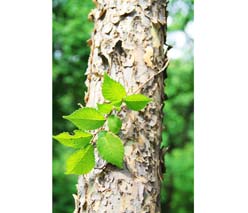

Ecological Gradient Analysis and Environmental Interpretation of Ulmus lamellosa Communities in the Taiyueshan Reserve, Shanxi
? These authors contributed equally to this paper
Received date: 2015-02-11
Accepted date: 2015-09-12
Online published: 2016-02-01
Many practices in afforestation and Ulmus lamellosa forest management were implemented for addressing the issues of tree species selection, planting regimes and development of structure. However, little is known about the ecological gradient and its relation with environment. We aimed to determine the factors controlling plant distribution and the importance of topography in determining local-scale spatial patterns of plants. The occurrence and distribution of plants were investigated on 60 plots in the Taiyue Mountain Reserve, Shanxi. Association types were classified by two-way indicator species analysis (TWINSPAN) and the relationship between the distribution and abundance of species and environmental gradients was analyzed by the canonical correspondence analysis (CCA) ordination method. Forward selection and Monte Carlo permutation tests were used to select the factors important in determining the plant distribution. The 60 survey plots were classified into seven groups characterized by the dominant tree species. The results of CCA ordination reflected the relationship between association structure and selected environmental variables. The distribution of 60 plots in CCA ordination was consistent with the results of TWINSPAN. Forward selection and Monte Carlo testing suggested that slope, slope position and elevation were the most important factors determining plant distribution. The effects of environmental factors, spatial factors and their interaction on the total variation of the U. lamellosa community pattern were quantitatively partitioned and showed that the contribution rates were 39.60%, 7.95%, 10.89% for environmental factors, spatial factors and their interaction, respectively, and 41.56% for other undetermined factors. Other unmeasured factors such as human activities and random events could play a role in determining the occurrence and distribution of herbaceous plants on the forest floor. Species coexistence was controlled by both niche differentiation and unified neutral theory of biodiversity.

Xiaomei Duan , Qindi Zhang , Jintun Zhang , Yufang Bai . Ecological Gradient Analysis and Environmental Interpretation of Ulmus lamellosa Communities in the Taiyueshan Reserve, Shanxi[J]. Chinese Bulletin of Botany, 2016 , 51(1) : 40 -48 . DOI: 10.11983/CBB15032
| 1 | 白玉芳, 毕润成, 白玉宏, 王晓霞, 张钦弟 (2014). 山西太岳山稀有濒危植物脱皮榆群落种间关联. 广西植物 34, 56-61. |
| 2 | 毕润成, 张杰, 苏俊霞 (2002). 山西稀有濒危植物脱皮榆的生态学特征. 植物资源与环境学报 11, 45-50. |
| 3 | 毕润成, 尹文兵, 王艳妮 (2003a). 山西南部脱皮榆种群生态位的研究. 西北植物学报 23, 1266-1271. |
| 4 | 毕润成, 陈李芳, 李培玉 (2003b). 山西南部脱皮榆群落生态特征及其物种多样性的研究. 武汉植物学研究 21, 109-116. |
| 5 | 杜盛, 古松, 谷瑞英 (1994). 脱皮榆离体培养中丛生芽形成与生长的研究. 内蒙古林学院学报 16, 24-28. |
| 6 | 杜盛, 闰美杰 (1996). 脱皮榆离体培养再生植株的研究. 内蒙古林学院学报(自然科学版) 18, 15-18. |
| 7 | 林洁, 沈泽昊, 贺金生, 陈伟烈 (1995). 珙桐群落学特征及群落环境分析. 植物学通报 12(专辑2), 71-78. |
| 8 | 刘秋锋, 康慕谊, 刘全儒 (2006). 中条山混沟地区森林乔木种的数量分类与环境解释. 植物生态学报 30, 383-391. |
| 9 | 邱扬, 张金屯 (2000). DCCA排序轴分类及其在关帝山八水沟植物群落生态梯度分析中的应用. 生态学报 20, 199-206. |
| 10 | 茹文明, 张桂萍, 毕润成, 张峰, 张金屯 (2007). 濒危植物脱皮榆种群结构与分布格局研究. 应用与环境生物学报 13, 14-17. |
| 11 | 上官铁梁, 马子清, 谢树莲 (1998). 山西省珍稀濒危保护植物. 北京: 中国科学技术出版社. |
| 12 | 邵方丽, 余新晓, 郑江坤, 王贺年 (2012). 北京山区防护林优势树种分布与环境的关系. 生态学报 32, 6092-6099. |
| 13 | 沈泽昊, 张新时, 金义兴 (2000). 地形对亚热带山地景观植被格局影响的梯度分析. 植物生态学报 24, 430-435. |
| 14 | 宋同清, 彭晚霞, 曾馥平, 王克林 (2010). 木论喀斯特峰丛洼地森林群落空间格局及环境解释. 植物生态学报 34, 298-308. |
| 15 | 王国宏, 杨利民 (2001). 祁连山北坡中段森林植被梯度分析及环境解释. 植物生态学报 25, 733-740. |
| 16 | 闫桂琴, 任鹰, 张变红, 李钻青 (2004). 三种木本植物基因组DNA的提取及纯度检测. 山西师范大学学报(自然科学版) 18, 72-77. |
| 17 | 余敏, 周志勇, 康峰峰, 欧阳帅, 米湘成, 孙建新 (2013). 山西灵空山小蛇沟林下草本层植物群落梯度分析及环境解释. 植物生态学报 37, 373-383. |
| 18 | Antoine G, Niklaus EZ (2000). Predictive habitat distribution models in ecology.Ecol Model 135, 147-186. |
| 19 | Borcard D, Legendre P, Drapeau P (1992). Partialling out the spatial component of ecological variation.Ecology 73, 1045-1055. |
| 20 | Burke A (2001). Classification and ordination of plant communities of the Naukluft Mountains, Namibia.J Veg Sci 12, 53-60. |
| 21 | Glenn M, Robert E, Brian H, David RF, Jonathan H, Dana M (2002). Vegetation variation across Cape Cod, Massa- chusetts: environmental and historical determinants.J Bio- geogr 29, 1439-1454. |
| 22 | Honnay O, Hermy M, Coppin P (1999). Effects of area, age and diversity of forest patches in Belgium on plant species richness, and implications for conservation and reforesta- tion.Biol Conserv 87, 73-84. |
| 23 | Koerner W, Dupouey JL, Dambrine E, Benoit M (1997). Influence of past land use on the vegetation and soils of present day forest in the Vosges Mountains, France.J Ecol 85, 351-358. |
| 24 | Leibold MA, Mcpeek MA (2006). Coexistence of the niche and neutral perspectives in community ecology.Ecology 87, 1399-1410. |
| 25 | McCune B, Mefford MJ (2012). PC-ORD. Multivariate Analysis of Ecological Data (Version 5). MjM Software De- sign, Oregon, USA. 2006. . |
| 26 | ter Braak CJF, Smilauer P (2002). CANOCO Reference Manual and CanoDraw for Windows User’s Guide: Soft- ware for Canonical Community Ordination (Version 4.5). Ithaca NY, USA: Micro-computer Power. |
| 27 | Woodward FI, Mckoo IF (1991). Vegetation and climate.Environ Int 17, 535-546. |
/
| 〈 |
|
〉 |